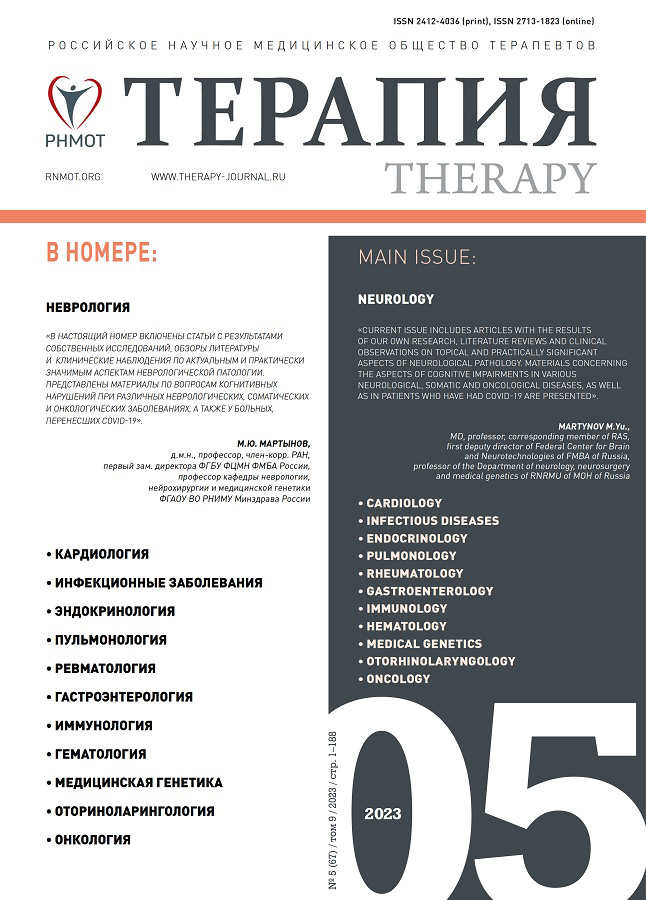Optimization of corticosteroid therapy for myastenia gravis
- 作者: Romanova T.V.1, Poverennova I.E.1, Persteneva N.P.2
-
隶属关系:
- Samara State Medical University of the Ministry of Healthcare of Russia
- Samara State University of Economics of the Ministry of education and science of Russia
- 期: 卷 9, 编号 5 (2023)
- 页面: 26-31
- 栏目: ORIGINAL STUDIES
- URL: https://journals.eco-vector.com/2412-4036/article/view/569008
- DOI: https://doi.org/10.18565/therapy.2023.5.26–31
- ID: 569008
如何引用文章
详细
Corticosteroids are used as first-line immunosuppressants in case of myasthenia gravis. The scheme and duration of this group of drugs, which allows to achieve the maximum effect of therapy, is still the subject of active scientific research.
The aim: to compare the efficacy of alternative steroid hormone regimens in patients with generalized myasthenia gravis by examining the correlation between dosing regimen and achievement of the optimal therapy goal.
Material and methods. We studied 43 patients with generalized form of myasthenia gravis with a severity of 2–4 classes according to the MGFA scale, who were divided into two groups depending on the dosing regimen of oral corticosteroid. The maximum dose of hormones was 0,8–1,0 mg per 1 kg of the patient’s body weight.
Results. The vast majority of patients responded well to therapy, they showed a significant improvement in their condition and a decrease in the need for anticholinesterase therapy, or a complete rejection of it. Comparative analyzes have shown the advantage of a slower dose reduction regimen. The condition of patients in this group 1–3 months after the end of treatment was significantly better in terms of daily functions, quality of life and survival than in the group receiving therapy according to the «short» regimen, and the onset and maintenance of remission after the end of steroid action was noted in 2,5 times more often.
Conclusion. Thus, reasonable and carefully selected standard therapy regimens significantly improve the results of myasthenia gravis therapy and the perspectives for patients.
全文:
作者简介
Tatyana Romanova
Samara State Medical University of the Ministry of Healthcare of Russia
编辑信件的主要联系方式.
Email: tvrom63@mail.ru
ORCID iD: 0000-0003-2851-8672
MD, Associate Professor, Professor of the Department of Neurology and Neurosurgery
俄罗斯联邦, SamaraIrina Poverennova
Samara State Medical University of the Ministry of Healthcare of Russia
Email: ipover555@mail.ru
ORCID iD: 0000-0002-2594-461X
MD, Professor, Head of the Department of Neurology and Neurosurgery
俄罗斯联邦, SamaraNatalya Persteneva
Samara State University of Economics of the Ministry of education and science of Russia
Email: persteneva_np@mail.ru
ORCID iD: 0000-0003-3845-5011
PhD in Economics, Associate Professor of the Department of Statistics and Econometrics
俄罗斯联邦, Samara参考
- Санадзе А.Г. Миастения и миастенические синдромы. М.: ГЭОТАР-Медиа. 2017; 256 с. [Sanadze А.G. Myasthenia gravis and myasthenic syndromes. Moscow: GEOTAR-Media. 2017; 256 рp. (In Russ.)]. ISBN: 978-5-9704-4026-1.
- Estephan E.P., Baima J.P.S., Zambon A.A. Myasthenia gravis in clinical practice. Arq Neuropsiquiatr. 2022; 80(5 Suppl 1): 257–65. https://dx.doi.org/10.1590/0004-282X-ANP-2022-S105.
- Романова Т.В., Калашникова В.В., Романов Д.В. Реабилитационный потенциал больных миастенией. Саратовский научно-медицинский журнал. 2020; 16(1): 371–377. [Romanova T.V., KalashnikovaV.V., Romanov D.V. Rehabilitation potential of patient with myasthenia gravis. Saratovskiy nauchno-meditsinskiy zhurnal = Saratov Journal of Medical Scientific Research. 2020; 16(1): 371–377 (In Russ.)]. EDN: FRWHHS.
- Антипенко Е.А., Лапшина О.В., Седышев Д.В. Возможности оптимизации терапии миастении гравис. Нервные болезни. 2022; (4): 54–56. [Antipenko E.A., Lapshina O.V., Sedyshev D.V. Opportunities for optimizing the therapy of myasthenia gravis. Nervnye bolezni = Nervous Diseases. 2022; (4): 54–56 (In Russ)]. https://dx.doi.org/10.24412/2226-0757-2022-12935. EDN: MQTPWH.
- Bubuioc A.M., Kudebayeva A., Turuspekova S. et al. The epidemiology of myasthenia gravis. J Med Life. 2021; 14(1): 7–16. https://dx.doi.org/10.25122/jml-2020-0145.
- Hehir M.K., Silvestri N.J. Generalized myasthenia gravis: Classification, clinical presentation, natural history, and epidemiology. Neurol Clin. 2018; 36(2): 253–60. https://dx.doi.org/10.1016/j.ncl.2018.01.002.
- Farmakidis C., Pasnoor M., Dimachkie M.M., Barohn R.J. Treatment of myasthenia gravis. Neurol Clin. 2018; 36(2): 311–37. https://dx.doi.org/10.1016/j.ncl.2018.01.011.
- Sathasivam S. Steroids and immunosuppressant drugs in myasthenia gravis. NatClinPractNeurol. 2008; 4(6): 317–27. https://dx.doi.org/10.1038/ncpneuro0810.
- Meriggioli M.N., Sanders D.B. Autoimmune myasthenia gravis: emerging clinical and biological heterogeneity. Lancet Neurol. 2009; 8(5): 475–90. https://dx.doi.org/10.1016/S1474-4422(09)70063-8.
- Gilhus N.E., Tzartos S., Evoli A. et al. Myasthenia gravis. Nat Rev Dis Primers. 2019; 5(1): 30. https://dx.doi.org/10.1038/s41572-019-0079-y.
- Nagane Y., Suzuki S., Suzuki N. et al. Early aggressive treatment strategy against myasthenia gravis. Eur Neurol 2011; 65(1): 16–22. https://dx.doi.org/10.1159/000322497.
- Imai T., Suzuki S., Tsuda E. et al. Oral corticosteroid therapy and present disease status in myasthenia gravis. MuscleNerve. 2015; 51(5): 692–96. https://dx.doi.org/10.1002/mus.24438
- Sussman J., Farrugia M., Maddison P. et al. Myasthenia gravis: Association of British Neurologists’ management guidelines. Pract Neurol. 2015; 15(3): 199–206. https://dx.doi.org/10.1136/practneurol-2015-001126.
- Sanders D.B., Wolfe G.I., Benatar M. et al. International consensus guidance for management of myasthenia gravis: Executive summary. Neurology. 2016; 87(4): 419–25. https://dx.doi.org/10.1212/WNL.0000000000002790.
- Jaretzki A.I., Barohn R.J., Ernstoff R.M. Myasthenia gravis: Recommendations for clinical research standards. Neurology. 2000; 55(1): 16–23. https://dx.doi.org/10.1212/wnl.55.1.16.
- Barnett C., Herbelin L., Dimachkie M.M., Barohn R.J. Measuring clinical treatment response in myasthenia gravis. Neurol Clin. 2018; 36(2): 339–53. https://dx.doi.org/10.1016/j.ncl.2018.01.006.
- Nagane Y., Suzuki S., Suzuki N. et al. Early aggressive treatment strategy against myasthenia gravis. Eur Neurol. 2011; 65(1): 16–22. https://dx.doi.org/10.1159/000322497.
- Lascano A.M., Lalive P.H. Update in immunosuppressive therapy of myasthenia gravis. Autoimmun Rev. 2021:20(1):102712. https://dx.doi.org/10.1016/j.autrev.2020.102712.
- Hehir M.K. 2nd, Li Y. Diagnosis and management of myasthenia gravis. Continuum (Minneap Minn). 2022; 28(6): 1615–42. https://dx.doi.org/10.1212/CON.0000000000001161.








